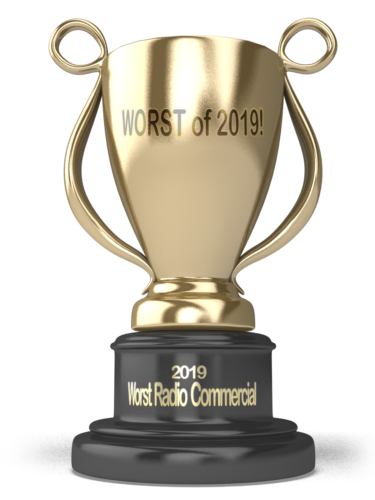 Although the season is less than half completed, we have our winner!
Although the season is less than half completed, we have our winner!
First, the radio commercial….
The single most important goal of the story in a story-driven radio commercial —
more important than believability…
more important than relevance…
more important than memorability —
is getting the targeted audience to listen to the damn commercial.
Putting aside for a moment the quality of the writing and the structure of the commercial itself, this spot opens with…
Okay, let’s do this: Go back to the beginning of the spot, play just the first sentence, stop the recording, then c’mon back here.
(No, really. Go re-listen to that first sentence, then we can continue.)
That first line isn’t bad storytelling. It isn’t any kind of storytelling.
It’s a Radio Announcer, reading “It was a beautiful June morning in Southern California” exactly as she reads “Your local Ford dealer proudly announces,” “Now through Saturday, Burger King is offering,” etc., etc., ad nauseam.
If Siri were to hear that line, she’d say, “Can’t you do ANYTHING to sound more like a human being??”
(Alexa would say the same thing — the only difference being she’d also secretly report to all of your contacts what station you’re listening to.)
Whether it’s a true story, make believe, comedic, satirical — the storyteller needs to be able to tell a story.
(At this point, I need to add my usual disclaimer: Perhaps the voice talent was reading the copy exactly as the producer or client told her to.)
With the second line, a male joins in. This guy is a genuine voice actor. I know that not because he sounds like a really good voice actor but because he sounds like a human being.
He might have a radio background. He might even work at the same radio station as his female storytelling partner, although I’m guessing he doesn’t.
If I had to guess, I’d say he’s not a station employee; he’s recording his lines at some remote studio of his own. Possibly he’s been given just his own solo lines without being privy to the entire dialogue.
That would explain why his first line is delivered so much better than his subsequent lines; why his voice jumps around so much more on his next line* while on the next suddenly he’s rushing his delivery to an unnatural pace. He’s being directed to “pick up the tempo” to compensate for an overlong script or a badly paced production.
*I can almost hear the distant voice of authority telling him, “Um, yeah, that’s good. How doing another but this time hitting the word ‘experiencing.’ You know, to make it more active.”
I could go further with this critique. And I will, because there are other big problems with the spot.
But if you’re in a hurry to get out of here, here’s just one valuable tip for your parting gift:
Beginning a radio commercial with a stereotypical “radio voice” trying to attract the target audience’s attention with a story is 100% as effective as having her deliver her lines with the microphone turned off.
Let’s Talk Testimonials
Recently we promoted the Home Study version of the ACX Master Class for audiobook narrators. (Not a sneaky plug. Registration is closed. Don’t insult me by trying to give me money now to get into the class.)
Someone who was trying to decide whether to take the class emailed me. In her email, she referred to the effectiveness of the class’s testimonials that she had been seeing and reading.
Effective Testimonials:
1) Are true.
2) Are, even if only minimally, stories.
A story takes the listener, viewer or reader on a journey.
“I used XYZ Roof Repair, and they repaired my roof real good. I highly recommend them” isn’t a journey.
3) Are specific.
4) Focus on a specific true story that is relevant to your targeted consumer’s own experiences, desires and fears.
5) Are told by real clients in their own words.
You can elicit those words by asking carefully chosen leading questions.
You can edit (without changing) those words for clarity, brevity, impact, etc.
You can rewrite a punchier, more compelling, more story-driven version and say, “The way I understand the story you just told me, your entire family was huddled underneath this one corner of the roof that wasn’t buckling from the hurricane’s impact, and that was the corner that XYZ Roof Repair had fixed for you..Is that right? Yeah? You want to try just telling that one part of the story into the microphone, so our listeners can get a really clear picture of what you were going through, how scary it was, and what role XYZ Roof Repair played in all of that?”
6. Are believable to your target audience. That believability is bolstered with a true, relevant, believably told story…
…that is related by a believable source.
What Makes a Testimonial Source Believable? What Factors Encourage Consumers to Trust a Testimonial?
It includes the person’s name.
Absolutely.
An anonymous testimonial isn’t worth the time you spent making it up.
It includes the city in which the person lives.
“James Smith says…”
“James Smith” probably is the single most common name in the U.S.
“James Smith of Lake Worth, Florida” is inherently more believable than simply “James Smith” because if someone really wanted to verify that that James Smith exists, trying to track down every James Smith in Lake Worth clearly is a more realistic goal than locating the right one of the approximately 33,000 James Smiths living in America.
Not that the consumer will try. But consumers take comfort in knowing they could try if they wanted to.
The person’s occupation.
Why does including the testimonial giver’s occupation add to the testimonial’s trustworthiness?
Once again, because it’s specific.
“S., Europe” engenders far less trust than
“Erick Van Broeck, Taxidermist
Antwertp, Belgium”
I haven’t seen the data to verify this, but a direct marketing colleague of mine (D.K., Ohio) insists that the most universally trusted occupation is….No, not attorney. Not doctor. Not radio station sales manager. It’s…
Nurses.
How High Does this Radio Commercial’s Testimonial “Story” Score in Trust Building?
Let’s see. The testimonial is from “Mr. and Mrs. J.P., Southern California.”
I’ll let you do the scoring on that one.
How Well Does this Radio Commercial’s Testimonial Story Relate to the Targeted Listener’s Own Experiences, Desires and Fears?
The person who emailed me about the ACX Master Class and volunteered a couple of reasons why she found the class’s testimonial videos so effective said:
“I have spent money in the past on equipment and classes with few meaningful results and no real support. Your testimonials are strong and don’t seem rehearsed and so many of them mention having been told by other people that the recording and editing are a nightmare. That’s probably my biggest fear….”
Of course as you read that paragraph, you would’ve found it more believable if I had cited the person’s name, location and profession.
But I’m not using it as a testimonial; I’m using it to help illustrate the effectiveness of a testimonial’s sounding “real and not rehearsed” and as reflecting the problems or worries the viewing (or reading) consumer is having.
That person believed and could identify with and be reassured by the true stories she was hearing from real people.
In our videos, every person is identified by name, profession and geographic location.
You’ll notice most those same attributes in every one of our print testimonials — almost all of which are accompanied by photographs of the individuals we are quoting. Those photographs are there to provide even more reassurance that those are real people.
Meanwhile, here’s the story told by the radio ad you just listened to:
“An anonymous couple somewhere in Southern California had a plumbing problem, the company they called came out and fixed it, and then a few months later they had another plumbing problem so they called the same company to come out and fix that problem, too.”
That is the most compelling rave review they could find for this spot? That is memorable and trust building?
Imaging a similar “testimonial” for a restaurant: “One day Mr. and Mrs. J.P. of Southern California felt hungry, so they went to XYZ Restaurant and ate something. A few months later, Mr. and Mrs. J.P. felt even hungrier, so they returned to XYZ Restaurant and ate something.”
Shall I wait while you grab a pen to jot down all the restaurant’s details?
Let’s return to the actual “story” this spot tells.
The mysterious Mr. and Mrs. J.P. had a clogged sink. The plumbing company sent someone to their home to unclog it. “A few months later, a much more (unspecified) intensive problem turned up in the bathroom. They worked up a plan, and a repair was made.”
I assume Netflix already has won a spirited bidding war for the screen rights to that riveting true story.
And yes, I did notice the sinister plot line lurking just beneath the clumsy words: They call a plumber to unclog their sink…and, purely by coincidence, a few months later a much bigger, undoubtedly more expensive plumbing problem appears in that same bathroom?
That cinches it. That’s definitely the plumber I’d want to call.
But Wait. They Still Have One Last Chance for this Testimonial to Have at Least Some Value.
The anonymous couple “felt so good about the experience to sit down and write us an email.”
Wow! Actually writing an email — that’s huge.
And did you hear that jaw-dropping declaration that Mr. & Mrs. J.P. ended the email by saying “they would use” that plumbing company on “future services and recommend them to anyone who needed plumbing repairs”?
Restaurant translation: “I’d eat at your restaurant again and I’d recommend your restaurant to people who happen to be hungry.”
Just When You Think They’ve Scraped Every Last Drip of Dumbness from this Radio Advertising Message
Understandably, they want to maximize the value to the advertiser of that unforgettable real-life customer experience.
Unfortunately, the technology doesn’t exist that would allow the advertiser somehow to record Mr. and/or Mrs. J.P. actually telling the story in their own voices.
Thank goodness the spot’s creators still found time to add not one but two Calls to Action:
1) Read the testimonial for yourself at the company’s website or
2) Just call the advertiser at their toll-free number, and somehow that will allow you to read that testimonial “and more.”
I’m guessing “and more” includes a thoughtful comparison between the writing of the testimonial and that of Shakespeare’s earliest works — y’know, before he sold out and started writing popular stuff.
I went to the company’s website in search of Mr. & Mrs. J.P.’s testimonial. I couldn’t find it. That doesn’t mean it’s not there. It just means I couldn’t find it.
If I lived in a “single consent” state, where it’s legal to record a telephone conversation if at least one of the parties to the call is aware of and gives consent to the recording (which essentially means it’s legal to secretly record your telephone conversation with someone else), I might call the advertiser’s toll-free number and say, “Hello. I’m calling to read Mr. & Mrs. J.P.’s testimonial and more” and share with you the results.
But I live in a dual consent state, so I can’t record such a conversation.
Finally, to that one person who is reading this and mumbling, “You don’t know nothin’. That’s a branding commercial”:
No, it’s not.


Comments on this entry are closed.
Dan that spot should be clogging toilets!!!